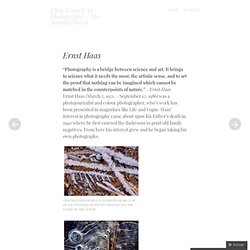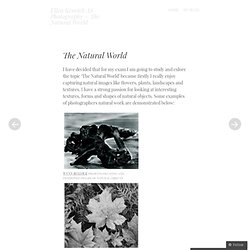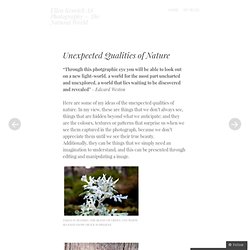

Ellen Kenrick AS Photography - The Natural World. “Photography is a bridge between science and art.

It brings to science what it needs the most, the artistic sense, and to art the proof that nothing can be imagined which cannot be matched in the counterpoints of nature.” - Ernst Haas Ernst Haas (March 2, 1921, – September 12. 1986) was a photojournalist and colour photographer, who’s work has been presented in magazines like Life and Vogue. Haas’ interest in photography came about upon his Father’s death in 1940 where he first entered the darkroom to print old family negatives.
From here his interest grew and he began taking his own photographs. Ellen Kenrick AS Photography - The Natural World. I have decided that for my exam I am going to study and exlore the topic ‘The Natural World’ because firstly I really enjoy capturing natural images like flowers, plants, landscapes and textures.

I have a strong passion for looking at interesting textures, forms and shapes of natural objects. Some examples of photographers natural work are demonstrated below: Wynn Bullock presents decaying and destroyed images of natural objects. Ansel Adams mainly looks at texturised objects and his photos allow us to clearly see the details of the objects. Adams also photographs landscape images that show interesting shapes. Edward Weston looks at shape and form of natural objects, and uses light to give the subject unique textures. Ernst Haas uses ice to freeze natural objects which creates unusual textures and is an independent presentation of natural objects. Bruce Rae uses the studio to present form and texture . Like this: Ellen Kenrick AS Photography - The Natural World. Ellen Kenrick AS Photography - The Natural World. Ellen Kenrick AS Photography - The Natural World.
“Through this photgraphic eye you will be able to look out on a new light-world, a world for the most part uncharted and unexplored, a world that lies waiting to be discovered and revealed” - Edward Weston Here are some of my ideas of the unexpected qualities of nature.

In my view, these are things that we don’t always see, things that are hidden beyond what we anticipate; and they are the colours, textures or patterns that surprise us when we see them captured in the photograph, because we don’t appreciate them until we see their true beauty. Additionally, they can be things that we simply need an imagination to understand, and this can be presented through editing and manipulating a image. Taken in Madrid, the blend of green and white suggest snow or ice is present. This photograph of the bark of a tree can present various images, for example one person noticed that it seems to present a forest, and someone else noticed that it looks like a beach. Like this: Like Loading... THEMES: Ordinary and/or Extraordinary - Natural World part 2 - The Elements. A lone figure gazing out an an expanse of sea.

Most of us have gazed out to sea and gained a sense of the vastness of the world, of the universe - this is the sublime. Casper David Friedrich breaks the whole world down to three elements - the blank foreground of land (earth), the blackish murky sea (water) and the vast empty bruise like sky (Air). It is almost abstract if seen through half closed eyes. It could be a late period Rothko with the same elements of bleakness and emptiness. This is a late period Rothko, created a year before the artist committed suicide. Earth Edward Weston - 'Cracked Earth Borego CA' Some images are destined to be taken again and again. 'Rock Formations Detail, Weston Beach, Point Lobos State Reserve, California', 1949 by Philip Hyde. Mario Giacomelli The patterns created by the grooves in the earth have been captured by Mario Giacomelli. Water Water is transformed into a stationary solid form and has been frozen in time. Autumn turns to Winter.
Irvin Penn M.C. Ellen Kenrick AS Photography - The Natural World. Ernst Haas (Austrian photographer) ERNST HAAS ESTATE. Ernst Haas. For the political scientist, see Ernst B.

Haas. Ernst Haas (March 2, 1921 – September 12, 1986) was a photojournalist and a pioneering color photographer. During his 40-year career, the Austrian-born artist bridged the gap between photojournalism and the use of photography as a medium for expression and creativity. In addition to his prolific coverage of events around the globe after World War II, Haas was an early innovator in color photography. His images were widely disseminated by magazines like Life and Vogue and, in 1962, were the subject of the first single-artist exhibition of color photography at New York’s Museum of Modern Art. Early life and education[edit] Haas was born in Vienna, Austria, on March 2, 1921.
Haas was raised in the grand cultural climate of Vienna before World War II. From 1935 to 1938, Haas attended LEH Grinzing, a private school in Vienna, where he studied art, literature, poetry, philosophy, and science. Introduction to photography[edit] Magnum Photos[edit] Ernst haas natural forms.